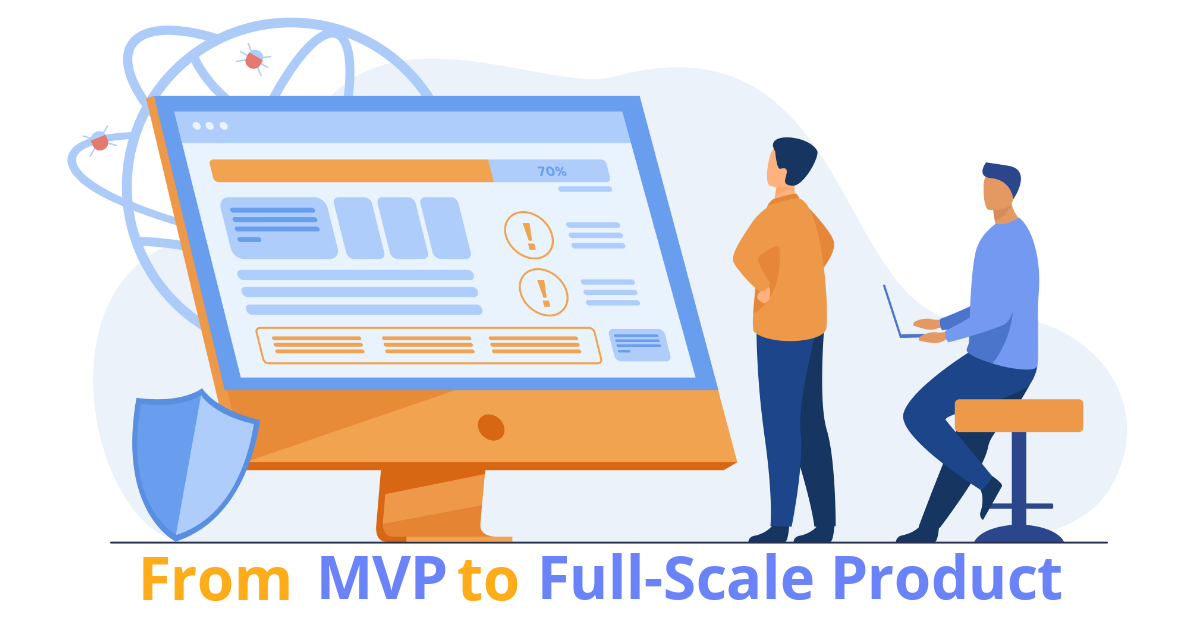Startup methodologies have discussed building a minimum viable product (MVP) and then scaling it to a full-scale product development solution counting on the user feedback. During this scenario, junking pieces of code may not match market expectations. An aspect that many product approaches have missed capturing is the way to scale a product just in case its beta release meets market expectation, and it must be mounted without any changes.
An organization needs to consider certain factors even once they are building a beta version of their product, for instance, ensuring that the planning of the answer supports distributed architecture even during the POC stage.
MVP development is an iterative process that doesn’t end until a product-market fit is developed.

Here are some steps to develop a full-scale product from an MVP
Collect Feedback
Until your MVP launch, you built an MVP that was based upon features that you thought were important concerning users in mind. But as soon as your MVP lands on the market, you’ve got a bit of higher advice to follow – the direction shown by the potential customers using your MVP.
Your job is to gather the ‘real data’ after launching your MVP to the market and find out why potential customers bought your product or why they didn’t.
By tracking the metrics or user behaviors critical to engine growth, you’ll measure and learn from user interactions and choose from there on which features to enhance, add, or delete. Use the info to research what it’s that might make your product more commercial and successful.
Don’t be discouraged with the feedback from the purchasers. Don’t hesitate to travel back to the situation, if needed, because most startups roll in the hay multiple times.
Prepare to Scale
In the world of startups, there seems to be an agreement on the very fact that to build an MVP, a crucial aspect of technical scalability is often avoided. All startups worry about testing their assumptions, validating an equivalent within the market, and gaining tremendous traction. The factor of scalability comes as a priority at the later stage.
Unfortunately, this blind belief has led to some brutal startup failures. A home-service startup, ‘TaskBob,’ that had raised around $5.7 million funding in 2014 had to pack up within the year 2017 because it was unable to proportion and generate profits.
Be prepared and optimistic, there’s always an opportunity of your MVP catching up quickly, and therefore the signups rolling in.
So, it’s essential to host your product on a fully scalable platform for a plethora of latest users. As an example, Dropbox decided not to launch any product in the least as an MVP. Instead, they came up with a smooth explainer video about what the merchandise does.
Thus, Dropbox made a planned move by launching its MVP with full preparation to digest the success with a perfect scalability dose.
Get Your Pricing Right
During MVP development or maybe after the launch of an MVP, startups mostly prefer to defer the ‘pricing quotient’ because they think that their product isn’t ready yet. They argue with an MVP definition on how you’ll possibly charge for a product that’s ‘minimal.’
But the purpose is that albeit the merchandise remains within the MVP stage, but you’ve got addressed the highest pain-points of the purchasers and followed a customer development process, you’re set to travel on a journey of success. A minimum viable product isn’t the synonym of a half-baked or a buggy product.
Buffer, for instance, identified this winning strategy. First, analyze the demand for the product with a basic MVP (a landing page) amongst the potential customers. Once their landing page started gaining traffic, they instantly added another page that carried the pricing plans to their signup process. As a result, the demand for the merchandise also as found an optimal monetization approach.
Better Marketing Approach
As discussed, MVP isn’t a final product, but a package in an early stage of development. However, once your MVP gets launched within the market, you ought to be ready together with your marketing strategy to let the planet know that your product is finally live.
It is better to start with the promotion of your product as soon as you launch your MVP. However, there’s a difference between marketing your MVP and marketing your final product.
Mint, a private finance app, maybe a real example of how they utilized an ideal marketing medium right from their MVP launch stage to witness the sunshine of success within the future.
The marketing plan of Aaron Patzer, the founding father of the Mint app, was “Whatever we will do, basically, for reasonable or for free of charge .” Therefore, the channel they chose to plug their product was Content Marketing. They began with a private finance blog to create an audience for Mint.
Conclusion
A Journey from MVP Development to Full-scale product development needs a lot of market analysis.
While there are enough pitfalls to avoid when building your MVP, even more, are going to be expecting you once you launch your MVP within the market.
However, after following all the points mentioned above, you’ll get to understand whether or not your idea features a spark; if it’s feasible to maneuver forward from MVP development to development. Remember to be unemotional and pragmatic about the results. If you didn’t get the specified effects, don’t throw the baby out with the bathwater. You would possibly be just a couple of tweaks far away from success.
If you are looking to expand your business then contact us today and get a FREE consultation from our technical team.
